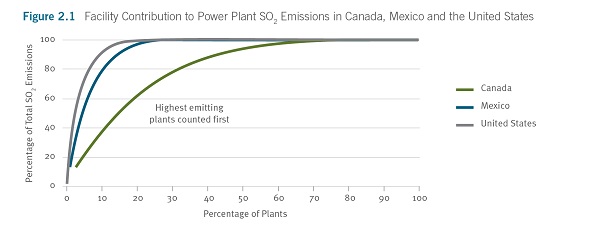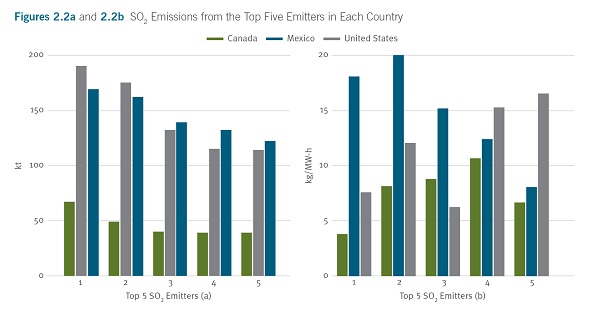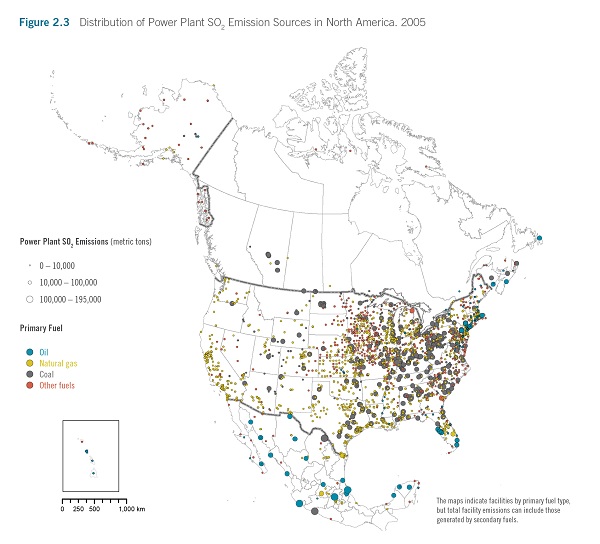Sulfur Dioxide (SO2)
Emissions of SO2 from fossil fuel-based electricity generation in each country are available here, along with other parameters such as electricity generation, emission rates and fuel type. Fuel types have been classified as Coal, Heavy Fuel Oil, Natural Gas and “Other Fuels” (the latter category includes fuels such as Liquefied Petroleum Gas, diesel, or coke). In the tables, data are sorted by SO2 emissions.
In Canada, only 38 plants (of 189 in total) reported emissions of SO2 to the NPRI, and 17 of those plants accounted for 90% of the total SO2 emissions reported by Canadian power plants for 2005. Each of them emitted more than 9,000 tonnes of SO2. The five plants with the highest reported SO2 emissions were in the range of 39,000 to 68,000 tonnes of SO2, and they were all coal-fired power stations with emission rates ranging from 3.8 to 10.6 kg/MW-h. Two of these five power plants were in Saskatchewan, with the three others located in the following provinces: Ontario, Nova Scotia, and Alberta. The top 10 facilities, ranked by SO2 emissions, accounted for 74% of the SO2 emissions from these 38 Canadian power plants.
A plant-by-plant comparison of Canadian power plant SO2 emissions between 2002 [1] and 2005 showed that five plants accounted for the entire decrease in the total SO2 emissions between those two years. For example, one of the plants, Coleson Cove, underwent an extensive refurbishment to have the output of all the units pass through a scrubber for flue gas desulfurization, thus achieving a 77% reduction in SO2 emission rates [40]. At the same time, NOX emission rates were reduced by 70% through modifications to the boiler.
Similar to the situation in Canada, the top 19 SO2-emitting facilities of a total of 102 in Mexico contributed 95% of that country's total SO2 emissions from fossil fuel electricity generation. The five highest-emitting plants had emissions ranging from 114,000 to just over 190,000 tonnes of SO2. Three of these were oil-fired and two were coal-fired power plants. Their emission rates ranged from 8 to 20 kg/MW-h, possibly indicating a lack of environmental controls for this pollutant in Mexico.
The top 10 facilities, ranked by SO2 emissions, accounted for 78% of the SO2 emissions from all 102 Mexican power plants in 2005 (Table 2.8). It should be pointed out that the figures for Mexico are based on estimations using emissions factors only; however, these estimates for SO2 are supported by mass and energy balance calculations.
In the United States, there were data on SO2 emissions from 2,724 out of 2,728 power plants, of which 263 plants accounted for 90% of the total SO2 emissions from fossil fuel electricity generation. Individual emissions of these 263 plants ranged from 9,000 to 170,000 tonnes of SO2 during the year. The emission rates of more than 82.5% of those 263 plants were below 10 kg/MW-h, but some values as high as 100 kg/MW-h were found—for example, for the LaFarge Alpena power plant in Michigan. Only 15 plants exceeded the 15 kg/MW-h emission rate. All but 15 of the 263 plants were coal-fired, one was gas-fired, and the rest were fueled with oil.
The top 10 facilities, ranked by SO2 emissions, accounted for 13% of the SO2 emissions from the 2,724 US power plants in 2005 (Table 2.9).
In relative terms, Figure 2.1 shows the contribution to SO2 emissions of all of the plants considered in this report, from the largest to the smallest emitters. The number of plants has been represented as a percentage of the total number of plants in each country. It should be borne in mind that plant emissions are dependent on the fuels and technologies used, and that the total number of plants significantly differs from country to country. In a graph of this type a straight line would represent equal contribution from all plants. It can be seen that only 10% of all the plants in the United States accounted for roughly 90% of that country's total SO2 emissions; for Mexico, it was around 15%, and for Canada, 45%.

The emission rate is a simple way to assess the overall environmental performance of a power plant. Lower emission rates indicate a better environmental performance. The emission rates depend on many factors, including fuel, combustion technology, electricity generation technology and environmental control technologies. In general, emission rates for natural gas are lower than for fuel oil, which in turn are lower than for coal, but plants with leading edge technologies for coal cleaning and flue gas desulfurization may have lower SO2 emission rates than some natural gas-fired power plants.
An example of a coal-fired power plant with outstanding technology for sulfur capture and with the lowest emission rates in the United States for coal (0.676 kg/MW-h) is the Cedar Bay Generating Plant, in Florida, which uses three fluidized bed boilers where almost all the sulfur from the fuel is trapped. In the eGRID database, there were six plants with data that resulted in exceedingly high emission rates (up to more than 100,000 kg/MW-h), which is obviously inconsistent. In the case of Mexico, oil- and coal-fired power plants have an average SO2 emission rate of 17.5 kg/MW-h, while diesel and natural gas based plants have an average SO2 emission rate of 0.1 kg/MW-h (excluding plants that use a combination of natural gas and fuel oil).

Figure 2.2 shows the emissions of the top five SO2-emitting plants in each country (graph on left), along with their emission rates (graph on right). It can be seen that the emissions of the top five SO2 emitters of Mexico and the United States were very similar, and were also significantly higher than the emissions of the top five SO2 emitters of Canada. However, the three highest emitters of Mexico had considerably higher emission rates than the three highest emitters of Canada and the United States.
The distribution of SO2 emissions from power plants considered in this report is shown in Figure 2.3. In this figure, the size of the dots represents the scale of emissions and the color represents the type of primary fuel used. SO2 emission sources related to electricity generation in Canada are highly localized.
The most important ones, with emissions ranging from 10,000 to 100,000 t/year, are five coal-fired power plants in Alberta, one in New Brunswick, one in Nova Scotia, one in Prince Edward Island, and one oil-fired power plant in each of the provinces of New Brunswick, Nova Scotia and Newfoundland and Labrador.
In Mexico, there are six important SO2 sources, three of which are oil-fired and three coal-fired power plants; their emissions range from 100,000 to 195,000 t/year. SO2 sources with emissions in the range of 10,000 to 100,000 t/year are distributed across the whole country; most are oil-fired power plants, but two use other fuels.
A very large number of power plants emitting SO2 are located in the eastern United States, with a significant concentration in California as well.
In the northeast and the southeast of the country, oil-fired power plants emit SO2 emissions typically between 10,000 and 100,000 t/year. On the other hand, coal-fired power plants emitting up to 195,000 t/year of SO2 are more widespread in the whole eastern side of the United States, with some in the central part of the country.


